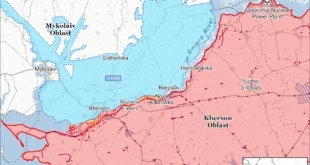Iran’s retaliatory strikes against Israel were not conducted alone. Strategic partners Russia and China have Tehran’s back, and their role in West Asia’s conflict will only grow if the US doesn’t keep Israel in check.
The Russian side keeps in contact with Iranian partners on the situation in the Middle East after the Israeli strike on the Iranian consulate in Syria.
Ryabkov added, “We stay in constant touch [with Iran]. New in-depth discussions on the whole range of issues related to the Middle East are also expected in the near future in BRICS.”
He then sketched The Big Picture:
Connivance with Israeli actions in the Middle East, which are at the core of Washington’s policy, is in many ways becoming the root cause of new tragedies.
Here, concisely, we had Russia’s top diplomatic coordinator with BRICS – in the year of the multipolar organization’s Russian presidency – indirectly messaging that Russia has Iran’s back. Iran, it should be noted, just became a full-fledged BRICS+ member in January.
Iran’s aerial message this weekend confirmed this in practice: their missile guidance systems used the Chinese Beidou satellite navigation system as well as the Russian GLONASS system.
This is Russia–China intel leading from behind and a graphic example of BRICS+ on the move.
Ryabkov’s “we stay in constant touch” plus the satellite navigation intel confirms the deeply interlocked cooperation between the Russia–China strategic partnership and their mutual strategic partner Iran. Based on vast experience in Ukraine, Moscow knew that the biblical psychopathic genocidal entity would keep escalating if Iran only continued to exercise “strategic patience.”
The morphing of “strategic patience” into a new strategic balance had to take some time – including high-level exchanges with the Russian side. After all, the risk remained that the Israeli attack against the Iranian consulate/ambassador’s residence in Damascus could well prove to be the 2024 remix of the killing of Archduke Franz Ferdinand.
And don’t forget the Strait of Hormuz
Tehran did manage to upend the massive western psychological operations aimed at pushing it into a strategic misstep.
Iran started with a misdirecting masterstroke. As US–Israeli fear porn went off the charts, fueled by dodgy western “intel,” the Islamic Revolutionary Guard Corps (IRGC) made a quick sideways move, seizing an Israeli-owned container ship near the Strait of Hormuz.
That was an eminently elegant manoeuvre – reminding the collective west of Tehran’s hold on the Strait of Hormuz, a fact immeasurably more dangerous to the whole western economic house of cards than any limited strike on their “aircraft carrier” in West Asia. That did happen anyway.
And once again, with a degree of elegance. Unlike that ‘moral’ army specialized in killing women, children, and the elderly and bombing hospitals, mosques, schools, universities, and humanitarian convoys, the Iranian attack targeted key Israeli military sites such as the Nevatim and Ramon airbases in the Negev and an intel center in the occupied Golan Heights – the three centers used by Tel Aviv in its strike on Iran’s Damascus consulate.
This was a highly choreographed show. Multiple early warning signs gifted Tel Aviv with plenty of time to profit from US intel and evacuate fighter jets and personnel, which was duly followed by a plethora of US military radars coordinating the defense strategy.
It was American firepower that smashed the bulk of what may have been a swarm of 185 Shahed-136 drones – using everything from ship-mounted air defense to fighter jets. The rest was shot down over Jordan by The Little King’s military – the Arab street will never forget his treachery – and then by dozens of Israeli jets.
Israel’s defenses were de facto saturated by the suicide drone-ballistic missile combo. On the ballistic missile front, several pierced the dense maze of Israel’s air defenses, with Israel officially claiming nine successful hits – interestingly enough, all of them hitting super relevant military targets.
The whole show had the budget of a mega blockbuster. For Israel – without even counting the price of US, UK, and Israeli jets – just the multi-layered interception system set it back at least $1.35 billion, according to an Israeli official. Iranian military sources tally the cost of their drone and missile salvos at only $35 million – 2.5 percent of Tel Aviv’s expenditure – made with full indigenous technology.
A new West Asian chessboard
It took only a few hours for Iran to finally metastasize strategic patience into serious deterrence, sending an extremely powerful and multi-layered message to its adversaries and masterfully changing the game across the whole West Asian chessboard.
Were the biblical psychopaths to engage in a real Hot War against Iran, there’s no chance in hell Tel Aviv can intercept hundreds of Iranian missiles – the state-of-the-art ones excluded from the current show – without an early warning mechanism spread over several days. Without the Pentagon’s umbrella of weaponry and funds, Israeli defense is unsustainable.
It will be fascinating to see what lessons Moscow will glean from this profusion of lights in the West Asian sky, its sly eyes taking in the frantic Israeli, political, and military scene as the heat continues to rise on the slowly boiling – and now screaming – frog.
As for the US, a West Asian war – one it hasn’t scripted itself – does not suit its immediate interests, as an old-school Deep State stalwart confirmed by email:
That could permanently end the area as an oil-producing region and astronomically raise the oil price to levels that will crash the world financial structure. It is conceivable that the United States banking system could similarly collapse if the oil price rises to $900 a barrel should Middle East oil be cut off or destroyed.
It’s no wonder that the Biden combo, days before the Iranian response, was frantically begging Beijing, Riyadh, and Ankara, among others, to hold Tehran back. The Iranians might have even agreed – had the UN Security Council imposed a permanent ceasefire in Gaza to calm the regional storm. Washington was mute.
The question now is whether it will remain mute. Mohammad Bagheri, chief of the General Staff of the Iranian Armed Forces, went straight to the point:
We have conveyed a message to America through the Swiss Embassy that American bases will become a military target if they are used in future aggressive actions of the Zionist regime. We will consider this as aggression and will act accordingly.
The US dilemma is confirmed by former Pentagon analyst Michael Maloof:
We have got some 35 bases that surround Iran, and they thereby become vulnerable. They were meant to be a deterrence. Clearly, deterrence is no longer on the table here. Now they become the American’ Achilles heel’ because of their vulnerabilities to attack.
All bets are off on how the US–Israel combo will adapt to the new Iranian-crafted deterrence reality. What remains, for the historic moment, is the pregnant-with-meaning aerial show of Muslim Iran singlehandedly unleashing hundreds of drones and missiles on Israel, a feat feted all across the lands of Islam. And especially by the battered Arab street, subjugated by decrepit monarchies that keep doing business with Israel over the dead bodies of the Palestinians of Gaza.
 Eurasia Press & News
Eurasia Press & News




